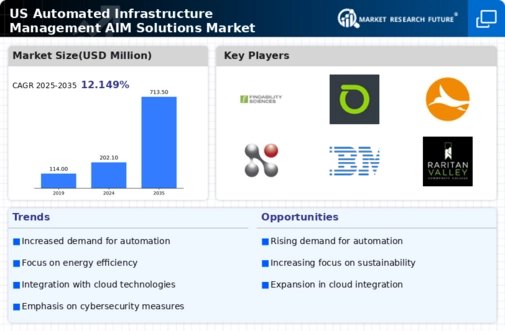Advancements in Cloud Computing
Advancements in cloud computing technologies are significantly impacting the automated infrastructure-management-aim-solutions market. The shift towards cloud-based solutions allows organizations to leverage scalable and flexible infrastructure management options. As businesses increasingly migrate to the cloud, the need for automated solutions that can manage hybrid and multi-cloud environments becomes paramount. The cloud infrastructure market is projected to grow to $832 billion by 2025, indicating a robust demand for automation in managing these complex environments. This trend suggests that organizations are seeking to enhance their infrastructure management capabilities through automation, driving growth in the automated infrastructure-management-aim-solutions market.
Growing Focus on Sustainability
The growing emphasis on sustainability is increasingly influencing the automated infrastructure-management-aim-solutions market. Organizations are under pressure to reduce their carbon footprint and enhance energy efficiency. Automation plays a crucial role in achieving these sustainability goals by optimizing resource usage and minimizing waste. According to estimates, companies that adopt automated solutions can reduce energy consumption by up to 25%. This focus on sustainability not only aligns with corporate social responsibility initiatives but also appeals to environmentally conscious consumers. As sustainability becomes a core business strategy, the demand for automated infrastructure-management-aim-solutions is likely to expand.
Integration of IoT Technologies
The integration of Internet of Things (IoT) technologies into infrastructure management is a pivotal driver for the automated infrastructure-management-aim-solutions market. IoT devices facilitate real-time monitoring and data collection, enabling organizations to make informed decisions regarding their infrastructure. The market for IoT in infrastructure management is projected to reach $50 billion by 2026, indicating a robust growth trajectory. This integration allows for predictive maintenance, reducing downtime and enhancing system reliability. As organizations increasingly adopt IoT solutions, the demand for automated infrastructure-management-aim-solutions is expected to rise, reflecting a shift towards more intelligent and responsive infrastructure management.
Regulatory Compliance and Standards
Regulatory compliance remains a critical driver for the automated infrastructure-management-aim-solutions market. Organizations are compelled to adhere to various industry standards and regulations, which often necessitate the implementation of automated solutions to ensure compliance. For instance, sectors such as finance and healthcare face stringent regulations that require meticulous data management and reporting. The cost of non-compliance can be substantial, with fines reaching millions of dollars. Consequently, businesses are investing in automated infrastructure-management-aim-solutions to mitigate risks associated with compliance failures. This trend underscores the importance of automation in maintaining regulatory standards and enhancing operational integrity.
Rising Demand for Operational Efficiency
The automated infrastructure-management-aim-solutions market experiences a notable surge in demand as organizations strive for enhanced operational efficiency. Companies are increasingly recognizing the potential of automation to streamline processes, reduce human error, and optimize resource allocation. According to recent data, businesses that implement automated solutions can achieve operational cost reductions of up to 30%. This trend is particularly pronounced in sectors such as IT and telecommunications, where the complexity of infrastructure management necessitates sophisticated solutions. As organizations seek to maintain competitiveness, the drive towards operational efficiency is likely to propel growth in the automated infrastructure-management-aim-solutions market.






















Leave a Comment